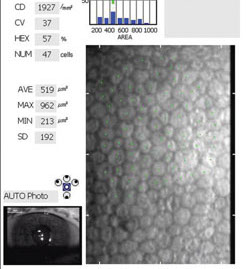 |
|
Corneal endothelial cells in patients with type 2 diabetes may suffer from more severe oxidative damage from UVA light. Photo: Francis W. Price Jr., MD. Click image to enlarge. |
Type 2 diabetes mellitus (T2DM) can compromise the health, sensitivity and proper function of the cornea. Recently, researchers found that the condition could also make corneal endothelial cells more vulnerable to oxidative damage from ultraviolet A (UVA) light. Their study, performed on T2DM and control mice, identified several mechanisms that may contribute to the increased corneal damage observed in diabetes.
Both diabetic and non-diabetic mice were exposed to UVA radiation at a cell-damaging dose of 150 J/cm2 in vivo. The researchers also noted in their paper on the study, “In vitro, human corneal endothelial cell line B4G12 treated with high glucose and low glucose were exposed to UVA light separately.”
Before and after irradiation, the researchers performed the following evaluations: anterior segment OCT scan, corneal imaging and corneal endothelial cell immunohistochemistry staining. After 14 days of UVA exposure, they also measured various cellular proliferation, apoptosis and pro-oxidant factors.
After analyzing the results, the researchers reported, “T2DM mice presented greater oxidant damage of corneal endothelial cells and more distinct corneal edema compared with control mice when they were irradiated with the 150 J/cm2 UVA light. In vitro, human corneal endothelial cells showed a significant decrease of proliferation, higher apoptosis extent, more reactive oxygen species generation, lower expressions of Parkinson’s disease protein 7 (DJ-1), nuclear factor-erythroid 2 related factor 2 (Nrf2), quinone oxidoreductase (NQO1) and distinct reduction of Nrf2 nuclear translocation compared with those in low glucose condition after exposing to 5 J/cm2 UVA light.”
It’s not necessarily surprising that in the presence of T2DM, eyes were found to be more vulnerable to UVA light. The prevalent metabolic disease is known to induce oxidative stress, and past studies have shown that corneal endothelial cell density is lower in patients with T2DM, the researchers pointed out.
“Increase of reactive oxygen species, downregulation of DJ-1/Nrf2/NQO1 expressions and decrease of Nrf2 nuclear translocation could result in T2DM making corneal endothelial cells more vulnerable to oxidative damage,” they concluded. In light of these findings, consider advising your patients with T2DM to avoid ultraviolet light to reduce the likelihood of corneal damage.
Zhang X, Qiu J, Huang F, et al. Type 2 diabetes mellitus makes corneal endothelial cells vulnerable to ultraviolet A-induced oxidative damage via decreased. Invest Ophthalmol Vis Sci. November 2022. [Epub ahead of print]. |

